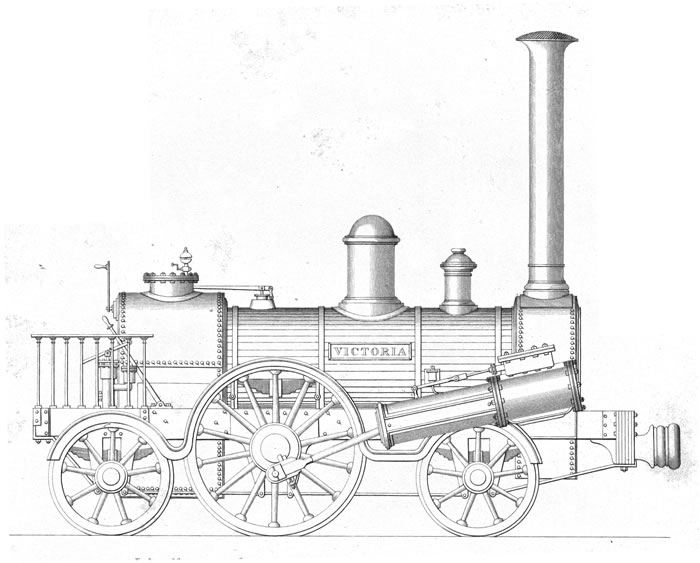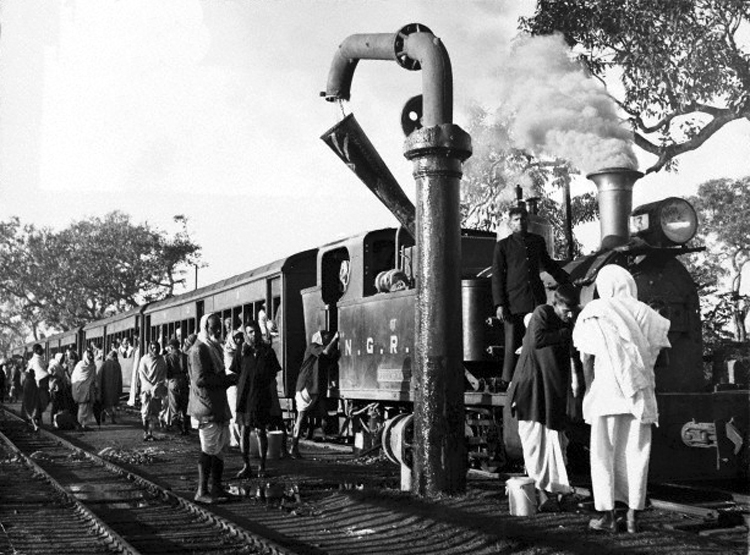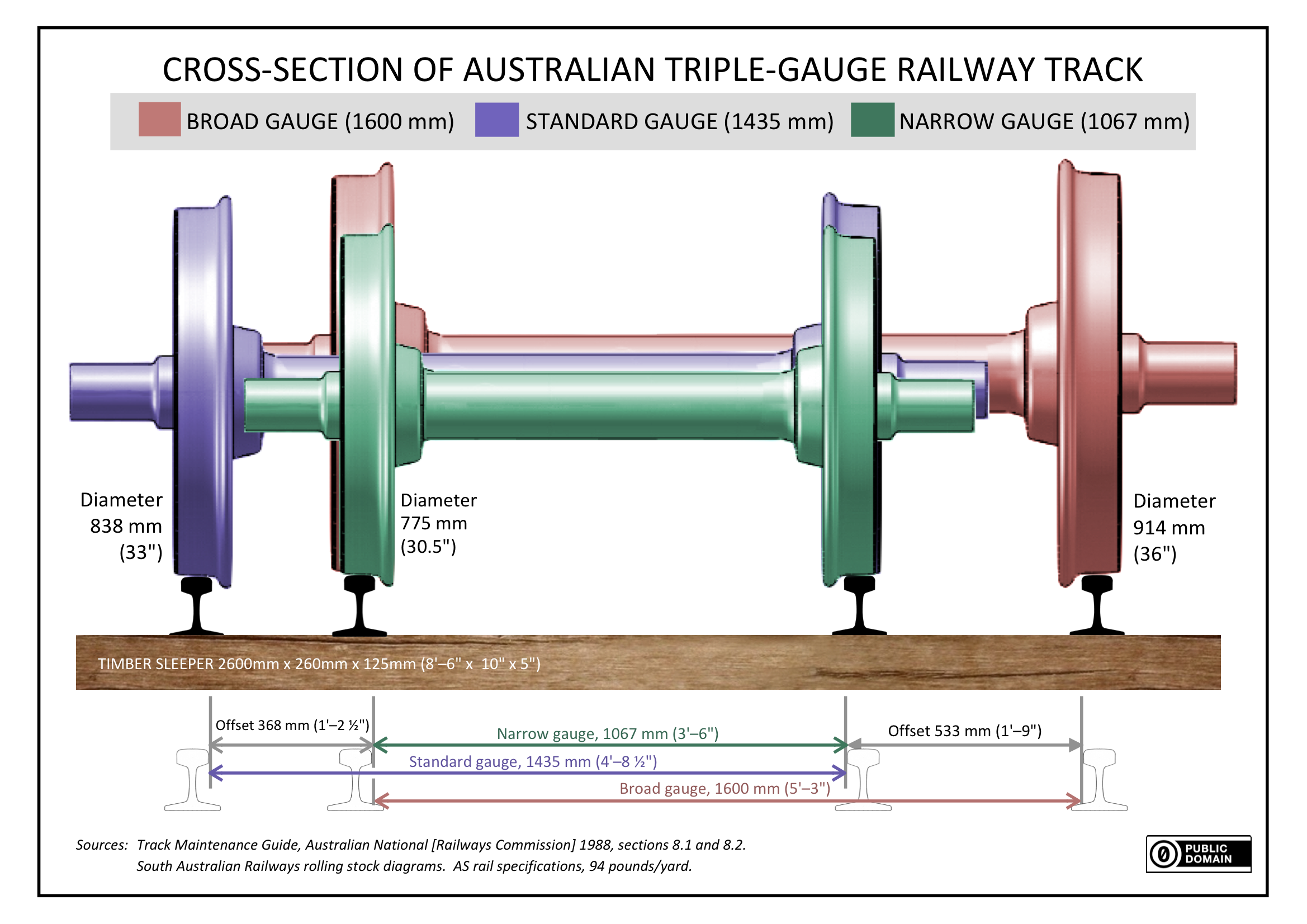|
Portland Gauge
(), also known as the Indian gauge is a broad track gauge, used in India, Pakistan, western Bangladesh, Sri Lanka, Argentina, Chile, and on BART (San Francisco Bay Area). In North America, it is called Indian, Provincial, Portland, or Texas gauge. In Argentina and Chile, it is known as "trocha ancha" (Spanish for "broad gauge"). In the Indian subcontinent it is simply known as "broad gauge". It is the widest gauge in use of heavy-duty mainline railways in the world. Asia India In India, the initial freight railway lines were built using standard gauge. In the 1850s, the Great Indian Peninsula Railway adopted the gauge of for the first passenger railway in India between Bori Bunder in Bombay and Thane.Indian Railways: Some Fascinating Facts“Train Atlas” ''Train Atlas'', Indian Railways, 2003 This was then adopted as the standard for the nationwide network. Indian Railways today predominantly operates on broad gauge. Most of the metre gauge and narrow gauge railways have ... [...More Info...] [...Related Items...] OR: [Wikipedia] [Google] [Baidu] |
Broad Gauge
A broad-gauge railway is a railway with a track gauge (the distance between the rails) broader than the used by standard-gauge railways. Broad gauge of , more known as Russian gauge, is the dominant track gauge in former Soviet Union countries (CIS states, Baltic states, Rail transport in Georgia (country), Georgia, Ukraine) and Rail transport in Mongolia, Mongolia. Broad gauge of , commonly known as five foot gauge, is mainly used in Rail transport in Finland, Finland. Broad gauge of , commonly known as Irish gauge, is the dominant track gauge in Ireland, the Australian state of Rail transport in Victoria, Victoria and Railways in Adelaide, Adelaide in South Australia and Rail transport in Brazil, passenger trains of Brazil. Broad gauge of , commonly known as Iberian gauge, is the dominant track gauge in Spain and Portugal. Broad gauge of , commonly known as Indian gauge, is the dominant track gauge in Indian Railways, India, Pakistan Railways, Pakistan, Bangladesh, Sri Lanka ... [...More Info...] [...Related Items...] OR: [Wikipedia] [Google] [Baidu] |
Rapid Transit In India
Urban rail transit in India plays an important role in intracity transportation in the major cities which are highly populated. It consists of rapid transit, Regional Rapid Transit System, suburban rail, monorail, and tram systems. According to a report published in 2025, a total of 36.5 billion people traveled annually in metro systems across India's fifteen major cities, placing the country as one of the busiest urban rapid transit hubs in the world in terms of commuters. In 2025, the Delhi Metro alone carries an average of 46.3 lakh (4.63 million) passengers daily, and the Delhi-Meerut RRTS has an operational speed of 160 kmph according to Wikipedia. Across all metro systems in India, daily ridership is expected to be significantly higher, possibly exceeding 10 million. As of 2025, the cumulative length of of eighteen metro systems in India makes it the List of metro systems#List by country, third longest in operation in the world. The Ministry of Housing and Urban Affai ... [...More Info...] [...Related Items...] OR: [Wikipedia] [Google] [Baidu] |
Arbroath And Forfar Railway
The Arbroath and Forfar Railway (A&FR) was a railway that connected Forfar with the port town of Arbroath, in Scotland. It opened in 1838–1839 and it was successful in making an operating profit, but it was always desperately short of capital. It used the track gauge of . When the Aberdeen Railway was authorised in 1845, it leased the Arbroath and Forfar line to form part of its main line connecting Forfar and Aberdeen; it opened in 1848. The Aberdeen Railway was to be a standard gauge line and the had to alter its track gauge. The line formed part of the main line from Stirling to Aberdeen, and when the North British Railway started running to Aberdeen in 1881, their trains too ran over a very short section of the . Nearly all of the line was closed in 1967 when the former North British Railway route was selected as the only route to Aberdeen, and the short section immediately north of Arbroath is the only section of the still in use. History Conception and authoris ... [...More Info...] [...Related Items...] OR: [Wikipedia] [Google] [Baidu] |
Dundee And Arbroath Railway
The Dundee and Arbroath Railway was an early railway in Scotland. It opened in 1838, and used the unusual track gauge of 5 ft 6 in (1,676 mm). In 1848 it changed to standard gauge and connected to the emerging Scottish railway network. It was absorbed by the larger Caledonian Railway, but when the North British Railway completed the construction of the Tay Bridge in 1878, it was granted part ownership of the line to enable it to form its main line to Aberdeen, so the line became the Dundee and Arbroath Joint Line. The main line is in use at the present day (except for the terminals at each end) as part of the Dundee to Aberdeen main line. History A scheme agreed Dundee had for centuries been a centre of trade on the Firth of Tay, but Arbroath too was an important port and manufacturing centre. The turnpike road and coastal shipping were both in heavy use connecting the two places. A railway had been proposed in 1826, but not proceeded with. In 1831 an inland-fac ... [...More Info...] [...Related Items...] OR: [Wikipedia] [Google] [Baidu] |
Scotch Gauge
Scotch most commonly refers to: * Scotch (adjective), a largely obsolescent adjective meaning "of or from Scotland" **Scotch, old-fashioned name for the indigenous languages of the Scottish people: *** Scots language ("Broad Scotch") *** Scottish Gaelic ("Scotch Gaelic") * Scotch whisky, a whisky made in Scotland, which outside Scotland is commonly abbreviated as "Scotch" Scotch may also refer to: Places * Scotch Corner, a junction of the A1 road and the A66 road in North Yorkshire, England Art, entertainment, and media * Scotch (band), an Italian disco/pop group during the 1980s * Hopscotch, a children's game * Scotch Game, a chess opening Brands and enterprises *Scotch, a brand name used by 3M until 1996 for recordable media, such as audio cassettes and video cassettes * Scotch Tape, a commercial brand name for a type of adhesive tape made by 3M Food and drink * Butterscotch, a confectionery * Scotch ale, a type of strong ale found in Scotland and North East England *Scotc ... [...More Info...] [...Related Items...] OR: [Wikipedia] [Google] [Baidu] |
Lahore Metro
Lahore Metro is an automated rapid transit system in Lahore, Punjab, Pakistan and the first driverless metro in Pakistan. Four metro lines have been proposed, of which the Orange Line is operational. It is also Pakistan's first metro line system. History The Lahore Metro was first proposed in 1991 and reviewed in 1993 by the ''Lahore Traffic & Transport Studies'', funded by the World Bank. The project was subsequently shelved. In 2005, the Ministry of Transport revisited the project and carried out a feasibility study. In 2007, the Asian Development Bank provided to conduct a study on the project. The initial plan called for an 82-kilometre (51 mi) rail network with 60 stations to be constructed in four separate phases. The first phase involved the construction of a 27-kilometre (17 mi) rail line between Gajju Matta and Shahdara Bagh, with an 11.6-kilometre (7.2 mi) section underground. Construction was expected to start in 2008 and be completed by 2010. However, in 2008, t ... [...More Info...] [...Related Items...] OR: [Wikipedia] [Google] [Baidu] |
Nepal Government Railway
The Nepal Government Railway (NGR) () was Nepal's first railway. Established in 1927 and closed in 1965, it linked Amlekhganj with Raxaul across the border in India in the south. The narrow gauge railway was 47 km long. History In 1923, a short narrow gauge railway was built by J. V. Collier of the Indian Forest Service to transport Nepalese timber to India. Collier had been assigned by Nepal's Rana prime minister to manage the forest department in Nepal. In the winter of 1924, Martin and Co. of Kolkata conducted a survey to construct a light railway from the border north to Bichako (Amlekhganj). Construction began in March 1926, and the Nepal Government Railway opened on 16 February 1927. The narrow gauge railway used a track gauge of . The railway possessed seven steam locomotives, 12 coaches and 82 wagons. It operated steam-powered Garratt locomotives manufactured by Beyer, Peacock & Company of England. Until the highway was built, the Amlekhganj-Raxaul railway was t ... [...More Info...] [...Related Items...] OR: [Wikipedia] [Google] [Baidu] |
Dual Gauge
Dual gauge railroad track has three or four rails, allowing vehicles of two track gauges to run on it. Signalling and sidings are more expensive to install on dual gauge tracks than on two single gauge tracks. Dual gauge is used when there is not enough room for two single tracks or when tracks of two different gauges meet in marshalling yards or train stations. Background The rail gauge is the most fundamental specification of a railway. Rail tracks and Wheelset (rail transport), wheelsets are built within engineering tolerances that allow optimum lateral movement of the wheelsets between the rails. Pairs of rails that become too wide or narrow in gauge will cause derailments, especially if in excess of normal gauge-widening on curves. Given the requirement for gauge to be within very tight limits, when the designed distance between the pair of wheels on a wheelset differs even slightly from that of others on a railway, track must be built to two specific gauges. That is ... [...More Info...] [...Related Items...] OR: [Wikipedia] [Google] [Baidu] |
Jamuna Bridge
Jamuna Multi-purpose Bridge (), is a bridge built over the river Jamuna in Bangladesh. The bridge was opened in June 1998. With a length of 4.8 kilometres, it is the second longest bridge of Bangladesh, Padma Bridge being the first. It connects Bhuapur on the Jamuna River's east bank to Sirajganj on its west bank. 90% of this bridge is under Tangail district and 10% under Sirajganj district. It was the 11th longest bridge in the world when constructed in 1998 and at present is the 6th longest bridge in South Asia. The Jamuna River, which it spans, is one of the three major rivers of Bangladesh, and is fifth largest in the world in discharge volume. History of construction The river Jamuna (Brahmaputra), along with the lower stretch of the Padma (Ganges) divides Bangladesh into nearly two equal halves. Until now all road and rail communication between the two parts of the country has had to rely on time-consuming ferry services that were often disrupted because of navigab ... [...More Info...] [...Related Items...] OR: [Wikipedia] [Google] [Baidu] |
Jamuna River
The Jamuna River () is one of the three main rivers of Bangladesh. The two other major rivers in Bangladesh are the Padma and the Meghna. The Jamuna is the lower stream of the Brahmaputra River, which originates in Tibet as Yarlung Tsangpo, before flowing through India and then southwest into Bangladesh. The Jamuna flows south and joins the Padma River near Goalundo Ghat, before meeting the Meghna River near Chandpur. The Meghna then flows into the Bay of Bengal. The Brahmaputra-Jamuna is a classic example of a braided river and is highly susceptible to channel migration and avulsion. It is characterised by a network of interlacing channels with numerous sandbars enclosed between them. The sandbars, known in Bengali as ''chars'', do not occupy a permanent position. The river deposits them in one year, very often to be destroyed later, and redeposits them in the next rainy season. The process of bank and deposit erosion, together with redeposition, has been going on cont ... [...More Info...] [...Related Items...] OR: [Wikipedia] [Google] [Baidu] |
Metre-gauge Railway
Metre-gauge railways ( US: meter-gauge railways) are narrow-gauge railways with track gauge of or 1 metre. Metre gauge is used in around of tracks around the world. It was used by several European colonial powers including France, Britain and Germany in their colonies. In Europe, large metre-gauge networks remain in use in Switzerland, Spain and many European towns with urban trams, but most metre-gauge local railways in France, Germany and Belgium closed down in the mid-20th century, although some still remain. With the revival of urban rail transport, metre-gauge light metros were built in some cities. The slightly-wider gauge is used in Sofia, Bulgaria. Another similar gauge is . __TOC__ Examples of metre-gauge See also * Italian metre gauge * Narrow-gauge railways A narrow-gauge railway (narrow-gauge railroad in the US) is a railway with a track gauge (distance between the rails) narrower than . Most narrow-gauge railways are between and . Since narrow-gaug ... [...More Info...] [...Related Items...] OR: [Wikipedia] [Google] [Baidu] |
Mumbai–Ahmedabad High-speed Rail Corridor
The Mumbai–Ahmedabad High Speed Rail Corridor (Mumbai–Ahmedabad HSR) is an under-construction high-speed rail line, which will connect Mumbai, Maharashtra, the financial hub of India, with Ahmedabad, the largest city in the state of Gujarat. When completed, it will be High-speed rail in India, India's first high-speed rail line, with a top speed of . The line is being developed by National High Speed Rail Corporation Limited, National High Speed Rail Corporation (NHSRC), a wholly owned subsidiary of Indian Railways, the Ministry of Railways and the Government of India. The line will use Shinkansen technology from Japan, including rolling stock, signalling and design standards – with technology transfer to support the Make in India programme. After delays due to the COVID-19 pandemic, construction commenced in February 2021 when NHSRC began to pour concrete to cast the corridor's first pillar. As of 2024, an initial section in Gujarat is expected to open by 2027, with the ... [...More Info...] [...Related Items...] OR: [Wikipedia] [Google] [Baidu] |





